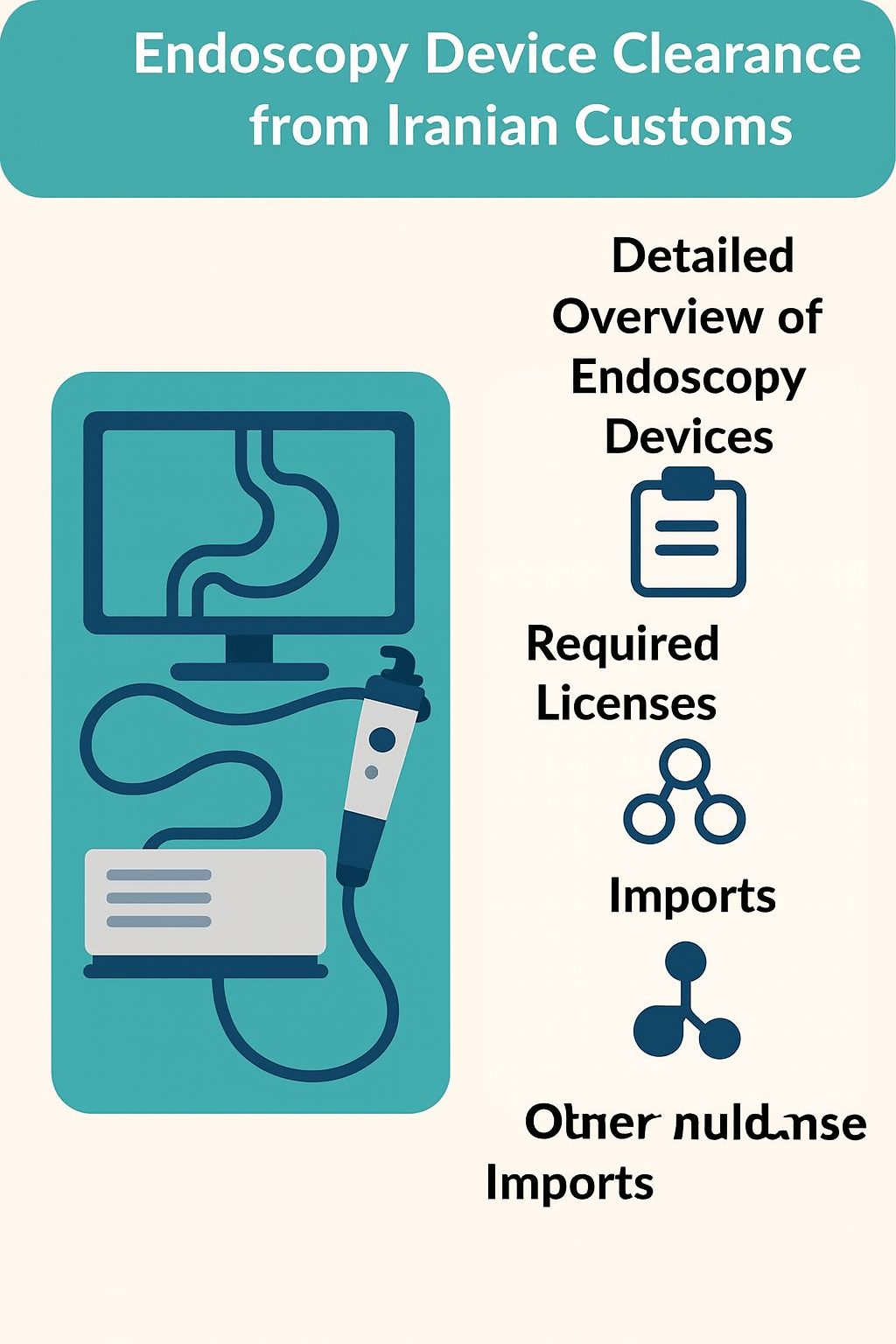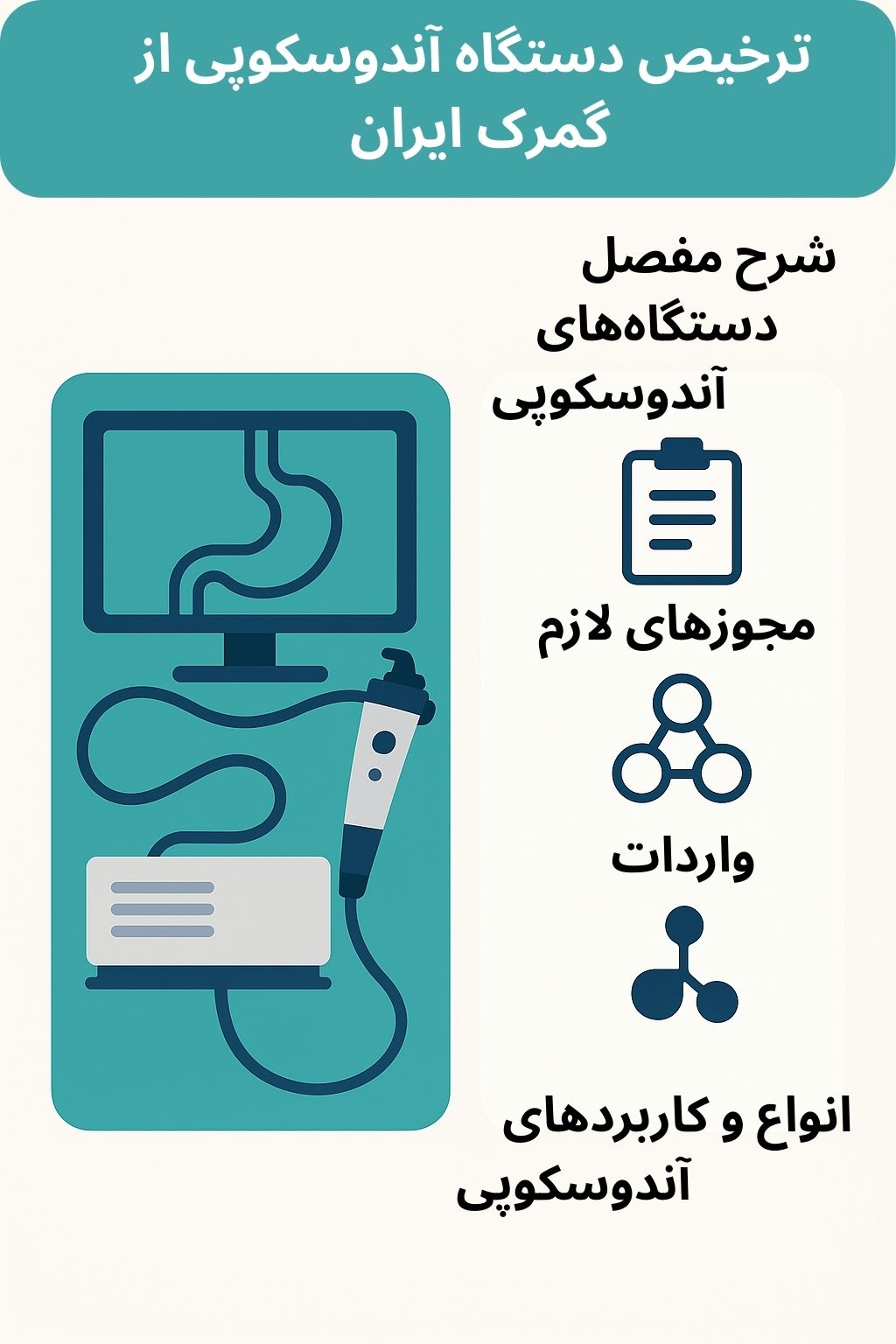Customs Clearance of Endoscopy Devices in Iran (HS Code, Documents & Permits)
Customs clearance of endoscopy devices: Endoscopy devices, as some of the most advanced medical equipment, play a key role in diagnosing and treating various diseases—especially in internal areas of the body such as the gastrointestinal tract, respiratory passages, and other vital organs. Using advanced technologies, these devices allow physicians to observe precisely without open surgery. Due to their sensitivity and importance for public health, importing and clearing them through customs requires strict compliance with regulations and legal requirements.
For an accurate estimate of endoscopy device clearance time and cost, contact Saba Tarkhis experts.
Instant free consultation
1) Detailed Description of Endoscopy Devices
Endoscopy devices are used to view inside the body without open surgery, and due to the sensitivity of their application, they require strict legal and sanitary compliance in import and clearance.
2) Types and Clinical Applications of Endoscopy
Clinical applications of endoscopes include use in the gastrointestinal system, respiratory tract, and other vital organs, and with advanced technology they enable precise visualization with minimal invasiveness.
3) Key Steps and Tips for Clearing Endoscopy Devices
1. Obtaining Import Permits
Importing endoscopy devices into the country, due to sanitary sensitivities and their importance in the health sector, is strictly supervised by relevant organizations. The first step is obtaining the necessary permits from competent authorities. The most important permits are:
- Permit from the Ministry of Health and Medical Education: Endoscopy devices must conform to national and international standards. After reviewing documentation and testing the devices, the Ministry issues the required approvals.
- Permit from the General Office of Medical Equipment: This permit ensures device quality and proper performance. Endoscopy devices must be registered and have a national medical device ID.
- Registration of these devices in systems such as “Iran Trade Single Window” and “IMED” (Medical Equipment System) is also a legal requirement.
2. Order Registration in Customs Systems
After obtaining the necessary permits, the next step is to register the import order for endoscopy devices in the Iran Trade Single Window. Acting as a bridge between the importer and customs, this system records required information such as proforma invoice, commercial invoice, packing list, and other essential documents. A key point here is entering technical and commercial data accurately, as any error can delay clearance.
3. Inspection and Quality Control
One of the most critical stages in clearing endoscopy devices is inspection and quality control by responsible bodies. The General Office of Medical Equipment and the National Standards Organization of Iran examine the devices upon entry. These inspections include performance tests, review of technical documents, and conformity to safety standards. Any deficiency may halt clearance or even lead to return of goods. Ensuring device quality and accuracy before shipment is therefore crucial.
4. Payment of Customs Duties and Taxes
Based on the tariff code of endoscopy devices and the assessed customs value, the importer must pay customs duties and taxes. These include customs charges, VAT, and in some cases other fees such as health surcharges. In certain circumstances, endoscopy devices may be eligible for customs exemptions or tax reductions; checking this before import can reduce costs.
5. Goods Release and Delivery to Destination
After completing the above steps and customs verification of documents, endoscopy devices are released. At this stage, arrangements for transporting the devices to the final destination (hospital, medical center, or warehouse) are made. Given the sensitivity and high value of this equipment, packaging and transport must be performed carefully and to safety standards to prevent any damage.
4) Customs Tariff for Endoscopy Devices and HS Code
The customs tariff is one of the principal stages in the import process, determining the duties and charges payable. Endoscopy devices are classified under different tariff groups depending on their type and application. Generally, these devices fall under HS Code 9018.19, which covers medical, surgical, dental, or veterinary instruments and appliances—endoscopy devices included.
To determine the precise tariff, the device’s technical specifications must be reviewed carefully. Factors such as country of origin, applied technology, unique features, and use case affect the final tariff. Working with experienced customs experts or licensed brokers helps ensure correct classification and prevents issues later.
5) Special Conditions for Importing and Exporting Endoscopy Devices
Compliance with Ministry of Health requirements and registration in specialist systems such as IMED, along with strict quality control upon entry, are key conditions. Eligibility for exemptions/discounts may also exist in certain cases.
6) Iran Market & 8) Global Market: Exporters and Importers
Exporter Countries
- Germany: As a leader in medical equipment, Germany supplies a significant share of the global endoscopy market with advanced technology and high-quality production.
- Japan: With technological innovation and high quality, Japan is also one of the largest producers of endoscopy devices worldwide.
- United States: Hosting major, reputable companies, the U.S. plays a prominent role in exporting endoscopy devices to global markets.
- South Korea: Rapid growth in technology and medical equipment has made South Korea a key exporter of these devices.
Importer Countries
- Iran: With expanding healthcare infrastructure and demand for advanced medical equipment, Iran is one of the largest importers of endoscopy devices in the Middle East.
- Saudi Arabia: Due to growth in its healthcare sector, this country is also a major importer of endoscopy devices.
- United Arab Emirates: With advanced hospitals and medical centers, the UAE is among the important importers of this equipment.
7) Trade Volume: Iran Imports/Exports & Overall Trend
Given healthcare needs, imports of these devices in Iran are substantial and growing alongside infrastructure development. Global exports are driven by technology-focused countries.

9) Required Documents for Clearing Endoscopy Devices
Clearing endoscopy devices from customs requires a set of documents to be carefully prepared and submitted to the relevant authorities. Below are the documents explained:
- Proforma Invoice: Contains technical specifications, unit price, quantity, total value, payment terms, and delivery terms. Issued by the seller as an offer to the buyer, it is the basis for order registration and later clearance steps.
- Commercial Invoice: Provides more detailed information on the goods and serves as the official sales document between seller and buyer, including technical specs, final price, payment terms, and party details.
- Packing List: Includes complete packaging details, number and type of packages, net and gross weights, package dimensions, and other relevant information. Used to check cargo contents and match with the commercial invoice.
- Certificate of Origin: Shows the country where the goods were produced. Issued by the exporting country’s chamber of commerce and may affect customs tariffs.
- Bill of Lading (B/L): The transport document issued by the carrier. It evidences title and the terms of carriage. The B/L must match the information in other documents.
- Certificate of Conformity (CoC): Confirms that imported endoscopy devices comply with national and international standards. Usually issued by accredited bodies and is a main requirement for medical goods clearance.
- Ministry of Health Permit: Mandatory for importing endoscopy devices. Demonstrates conformity with sanitary and safety requirements and must be obtained prior to import.
- Order Registration in Iran Trade Single Window: Mandatory for importing any goods. This step includes entering information about the goods, customs value, and other details needed for clearance.
- Pre-shipment Inspection Certificate (PSI): Shows that inspection was performed before shipment from the origin country. Some countries and goods require it to ensure quality and correctness before dispatch.
- IMED Registration Certificate: For medical devices including endoscopy systems, registration in the Medical Equipment System and obtaining a national device ID is necessary, demonstrating legal registration in Iran and compliance with national regulations.
- Customs Declaration: Prepared by the importer and includes complete information about the imported consignment. Submitted to customs as the basis for valuation and release.
- Insurance Certificate: Shows insurance coverage against potential damages during transportation. Essential for sensitive, high-value devices like endoscopy systems.
- Cargo Manifest: Lists all goods carried on a single vehicle (ship, aircraft, truck). Submitted to customs and must match other documents.
- Release Note: Issued by customs after full payment of duties and taxes, allowing the importer to clear goods from customs.
- Health/Sanitary Certificate (if required): Depending on device type and import conditions, health certificates from competent authorities may be required to confirm safety for use in medical centers.
- IMED Registration Certificate:
For medical devices including endoscopy systems, registration in the Medical Equipment System and obtaining a national device ID is necessary, demonstrating legal registration in Iran and compliance with national regulations.
Customs Declaration:
Prepared by the importer and includes complete information on the imported consignment. Submitted to customs as the basis for valuation and clearance.
Insurance Certificate:
Indicates insurance coverage against potential damage during transportation. A valid policy is essential for sensitive, high-value devices like endoscopy systems.
Cargo Manifest:
Contains a complete list of goods transported by a single vehicle (ship, aircraft, truck). Submitted to customs and must match other documents.
Release Note:
Issued by customs after full payment of duties and taxes, allowing the importer to clear goods from customs.
Health/Sanitary Certificate (if required):
Depending on device type and import conditions, health certificates from competent authorities may be required to confirm safety and suitability for use in healthcare facilities.
These documents must be prepared completely and accurately and submitted to the relevant authorities. Any deficiency or error can cause delays or even return of goods. Importers are advised to work with experienced experts and customs brokers to ensure a correct, trouble-free clearance process.
Key Tips and Practical Advice
- Finalize the Ministry of Health permit and IMED registration before final shipment to avoid customs holds.
- Keep commercial documents (Invoice/PL/B/L) consistent with the device’s technical information.
- For tariff disputes, attach technical documents to support classification under HS 9018.19.
Frequently Asked Questions
What is the HS Code for endoscopy devices?
Generally, endoscopy devices are classified under 9018.19.
What permits are required for import?
Ministry of Health permit, IMED registration, standards compliance, and complete commercial documents (Invoice/PL/B/L).
How can we reduce clearance time?
Obtain permits in advance, record technical data accurately, and use a specialist broker to coordinate inspections.
Special Customs Clearance Services by Saba Brokerage
With years of experience in customs clearance, our brokerage provides comprehensive, specialized services for importers of endoscopy devices. These services are designed so that all clearance steps are carried out accurately and with minimal hassle for importers.
- Specialized consultation: Our experts, fully versed in customs rules and regulations, provide professional advice on selecting the correct tariff code, how to register orders, and obtaining required permits. This guidance helps importers avoid potential problems during clearance and proceed with greater confidence.
- Handling all clearance steps: Our team manages all stages—from order registration to obtaining permits, coordinating inspections and tests, paying duties and taxes, and finally releasing the goods—thoroughly and precisely, ensuring your goods clear customs quickly and without issues.
- Continuous follow-up and status updates: A distinctive feature of our services is ongoing follow-up and timely client updates. We closely monitor each step, keep clients informed of progress, and rapidly address any problems or delays so the process continues smoothly.
- Post-clearance services: Even after release, our team stays with you. Post-clearance services include domestic transport, warehousing, and delivery to the final destination. If returns or value appeals are needed, we provide full support so subsequent procedures are efficient and trouble-free.
This suite of specialized services ensures your endoscopy device imports proceed smoothly and worry-free, so you can focus on your business and benefit from the added value of importing.
Contact our experts for more information.
.png)
